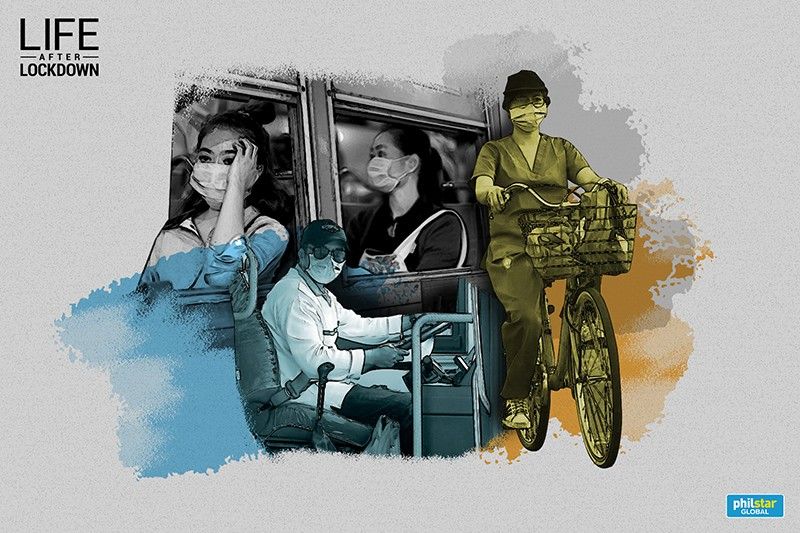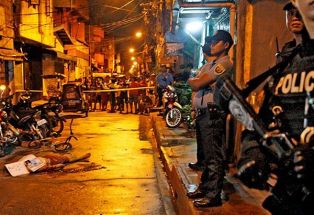Life After Lockdown: Limited operations for land transport as more Filipinos hit the road

Philstar.com's Life After Lockdown is a compendium of references on Filipinos' shift to a new normalcy during a coronavirus pandemic.
MANILA, Philippines (First published May 25, 10:45 a.m.) — In between the initial declaration of quarantine and the more stringent enhanced community quarantine was a distinctly static period of limbo and uncertainty, during which the rising tension throughout Metro Manila was palpable for many.
Means of getting from point A to point B were among the first things to go as the novel coronavirus came like a thief in the night.
It was at once faulty in both impulse and in decision-making: while public transportation was largely suspended, work for many was still in full swing, leaving much of the informal sector without many choices sans government support.
For the over 50 days of enhanced community quarantine, this has been the new normal; after the possible ECQ lifting on May 15, many hope for relief.
- The LRT-1, LRT-2, MRT-3, and Philippine National Railway will resume operations—albeit in a limited capacity—after the lifting of the strict lockdown on May 16, according to the Department of Transportation's latest guidelines dated May 3.
- Public utility buses (PUBs), UV Express, taxis and public utility jeepneys (PUJs) are expected to have tight restrictions on their allowed ridership. Land Transportation Franchising and Regulatory Board (LTFRB) Chairman Martin Delgra III explained where they are allowed to operate:
- Buses will be prioritized as they have a larger passenger capacity.
- In areas where buses cannot serve passenger demand or have road characteristics that do not permit their operations, modernized PUVs are the next priority.
- In areas where buses and modern PUVs are unavailable, jeepneys and UV Express services may operate.
- In areas where no other mode of transportation is available, tricycles may be permitted to operate as determined by the LTFRB and corresponding LGU.
How will they operate? “Public transportation in the road sector will be available in areas declared under GCQ but we will strictly impose health safety standards at all times to ensure the safety of our drivers and passengers,” Mark Richmund de Leon, assistant secretary for road transport and infrastructure, said.
According to the Omnibus Public Transportation Protocols and Guidelines set by the DOTr and the IATF-EID, all permitted PUVs, transport terminals and operators must follow three essential components:
- Safety guidelines that reduce contact, transmission, and spread of the virus through the mandatory use of face masks and gloves for drivers. Thorough disinfecting practices of vehicles, terminals, and even among passengers are also required.
- Capacity and passenger load factors required for each mode of transportation to ensure that physical distancing is followed.
- Coverage or passenger load for public utility vehicles (PUVs) including buses and jeepneys should not exceed half of the vehicle’s capacity, excluding driver and conductor.
Commuting and land transport • Movement of people • Industries • Air travel • Education • Reopening of industries and workplaces • Work-from-home setup • Digital economy • Government services • Courts, cases and law enforcement • Religious services and churches • Sports interactions • Sports • Local sports leagues • Dining and beverage • Television, movies, music and events
Along with these regulations, the following individuals will not be allowed inside any rail transport stations, according to the DOTr:
- Passengers not wearing required face masks
- Passengers showing COVID-19 symptoms or with a body temperature of 37.8°C or higher
- Senior citizens, passengers below 21 years old
- Pregnant women due to their susceptibility to COVID-19.
Sought for comment by Philstar.com, Goddes Libiran, communications assistant secretary at the Department of Transportation, noted that all social distancing measures recommended by the Department of Health will be adopted by the transportation department.
- "The new normal is wearing of face masks and strict observing of social distancing not only inside but also in queueing, and regular disinfection and putting up hand washing facilities. Things like that," Libiran said.
- Consequently, markings, signage, tarpaulins, and other logistic accouterments have been put up in stations and train cars to ensure these rules are implemented and complied with.
PNR General Manager Jun Magno has said that they expect PNR, MRT, and LRT-2 to be operational at just a fourth of its capacity during the lifting of ECQ
- LRT-1: 43 per train car, 158 per train set, or only 12% of its capacity
- LRT-2: 40 per train car, 160 per train set, or only 10% of its capacity
- MRT-3: 51 per train car, 153 per train set, or only 13% of its capacity
- PNR: 148 average persons per train car or 20% capacity on average
Other modes of transportation have similar capacity regulations, namely:
- Passenger load for UV Express and taxi vehicles should not exceed two passengers per row, with the exception of the driver’s row where only one passenger is allowed.
- Tricycles, on the other hand, must not exceed one passenger in the side-car, while riding on the back seat, as with all motorcycles, will not be allowed.
- Cars will only be allowed one passenger to occupy the front passenger seat, while front-facing seats shall not exceed two passengers per row.
Drivers and conductors shall mandatorily wear masks and gloves at all times while commuters are also required to wear masks in order to be allowed to board a PUV.
The Land Transportation Franchising and Regulatory Board (LTFRB)-Region 2 has also released guidelines for provincial areas under GCQ, though it is unclear if Metro Manila will be following the same guidelines should it also be placed under a general quarantine.
- Private cars and motorcycles will be allowed to operate solely for essential travels as defined by the Inter-Agency Task Force for the Management of Emerging Infectious Diseases (IATF-EID), while the LTFRB has finalized the mechanism for issuing special permits to allow PUVs to operate.
- A no-backriding rule for motorcycle riders and a maximum of 3 passengers in private vehicles plus the driver will be enforced.
- Bicycles and personal mobility devices have also been encouraged by the department, which said that these could help quell the spread of the virus. In line with this, LGUs have also been encouraged to identify bike-only roads and lanes for these passengers.
What challenges are expected? MRT-3 management has warned the public to brace for longer waiting times that could last from two to three hours under the new system, MRT-3 Director Michael Capati was quoted as saying in an Unang Balita report.
- Existing traffic woes from before the outbreak also cannot be overlooked, as these can easily come back with a vengeance amid a global pandemic. At the time, each day saw 440,000 cars slither along the capital’s main thoroughfare, far exceeding EDSA’s listed carrying capacity of 220,000.
- Longer queues and crowding can leave hundreds of thousands of passengers more exposed. The LRT-1 and LRT-2 carry about 579,000 passengers each day, while the MRT-3 line, which runs along the length of the Epifanio de los Santos Avenue, carries more than 400,000 passengers daily, a far cry from its peak of over 500,000 from nearly a decade ago, according to a 2012 assessment of the Philippine transport sector by the Asian Development Bank.
Social distancing in public transport a big ask: With rules being gradually relaxed under the possible general community quarantine, so too will people's movement, a scenario that doesn't bode well for public transportation.
- In an earlier exchange, Jerome Adonis, chairperson of labor group Kilusang Mayo Uno told Philstar.com in Filipino: "That's hard to implement because during rush hour there are a lot of passengers. Even if there isn't anyone standing in the bus, the chairs are still next to each other, so there isn't any distance between passengers."
What about infrastructure? Amid the shifts in enforcement, the transportation department said that it would begin work on infrastructure projects anew. According to Libiran, the following projects have been given the green light by the IATF-EID to proceed with limited works:
- LRT-1 Cavite Extension
- LRT-2 East Extension
- LRT-2 West Extension
- LRT-2 Fire Restoration
- MRT-3 Rehabilitation
- MRT-7
- Metro Manila Subway
- Common Station
- PNR Clark 1
- PNR Clark 2 and Calamba
- Subic-Clark Railway
- PNR Bicol
- Mindanao Railway
The LRTA, too, said that it was "exhausting all efforts to ensure the restoration of Santolan-Anonas despite it being adversely affected by the ECQ." The three westward stations of the line, from Santolan to Katipunan to Anonas, remained out of commission when the quarantines were announced, which could only serve to worsen the passenger backlog with the new rules.
However, the DOTr said that the following conditions would be imposed on all limited works:
- Limited mobilization of personnel and skeletal staffing pattern must be observed;
- On or near-site accommodations and/or point-to-point shuttle services must be provided;
- Regular disinfection of workplaces, shuttles, and accommodations must be done;
- Regular monitoring of personnel's health, especially for COVID19 symptoms, must be practiced; and
- Strict social distancing measures proper hygiene, and other precautionary measures must be observed at all times.
Sought for comment by Philstar.com, Ibarra Paulino, executive director of the Philippine Constructors Association, an industry group that claims to corner around 80% of state projects, supported the government’s decision to proceed with its building program, even suggesting that the Department of Public Works and Highways (DPWH) do the same for some road projects while most people are indoors, such as the long-overdue rehabilitation of EDSA thoroughfare.
- Latest
- Trending































